Introduction
Cervical cancer, major cancer affecting women in developing countries, is caused by the persistent infection of “high-risk” genotypes of human papilloma viruses (HPV). Human papilloma viruses are DNA viruses that infect basal epithelial (skin or mucosal) cells. HPV is highly transmissible, with the peak incidence after the onset of sexual activity. Clinical and subclinical HPV infections are the most common sexually transmitted diseases today. There are more than 100 known HPV genotypes, at least 15 of which can cause cancer of either cervix or other sites. There is an international consensus indicating that “high-risk” genotypes, including genotypes 16, 18, 31, 33, 35, 39, 45, 51, 52, 56, 58, 59 and 66, could lead to cervical cancer. Among all, 16 and 18, the two most common oncogenic types, cause approximately 70% of all cervical cancers, worldwide, while HPV 6 and 11, can also cause genital warts. On the other hand, as not all the cervical HPV infection is symptomatic, 5—40% of women at reproductive age might be infected by HPV without suffering any symptoms(1-4). There have been many studies worldwide on the proportion of cervical cancer, high- and low-grade squamous intraepithelial lesions (HSIL and LSIL) due to different HPV genotypes (5-9).
HPV vaccine that is avaliable for clinical use, was able to be developed in bivalent and quadivalent forms. The vaccines are successful in the profilaxis of 70 % of all cervical cancers. By the use of quadrivalent vaccine about 90 % of genital wart formation can be prevented. In the clinical studies, HPV vaccine has been shown to close to 100 % protective against the formation of genital wart, precancerous and cancerous cervical lesions caused by HPV type 6, 11, 16 and 18 (10-13).
Materials and Methods
Through the years 2008-2010, 2161 women who have admitted to gynecology clinics in Ankara Bayındır private hospital, İstanbul Bilim University Hospital and İstanbul GATA military hospital were evaluated for cervical cytology, demographical characteristics and HPV infection. In order to assess the cervical cytology, the samples collected from cervical os and posterior vaginal fourcette by a brush, were fixed and send to the pathology laboratory. The women were conducted into subgroups, normal, ASCUS, HSIL, LSIL according to cervical cytology. The cervical samples of the patients who had genital warts and were suspected to have HPV infection (perinuclear halo and coilocytosis in cervical smear) by the evaluation of their cervical cytology, were collected for the HPV DNA scanning and HPV typing. It were made to HPV DNA and subtype analysis to patients who had suspected of HPV infection. HPV DNA analysis were not made to all patients. For this purpose, the samples were collected from cervical ostium by the help of a brush and send to the pathology laboratory in ‘’The Thin Prep Preserv Cyt solution 20 ml cytyc corp’’ solution.
By using the primers specific for the E6 and E7 regions of the HPV subtypes 6, 11, 16, 18, 31, 33, 35, 45, 51, 52, 56, 58, 59, 68, multiplex fluoresans polymerase chain reaction (PCR) performed in order to screen HPV DNA and determine the type . One hundred and eighty nine cases who received ASCUS diagnosis by cervial cytological evaluation were undergone for reevaluation colposcopic observation and/or cervical biopsies. Thus, by the results of the reevaluation, the patients with ASCUS diagnosis have been moved into groups either normal, HSIL or LSIL. According to the HPV prescence, the normal, HSIL and LSIL groups were subdivided. Each patient was questioned for their number of delivery. All results were expressed as the mean ± StDev. Two independent groups were compared with Mann-Whitney U-test. A p value of less than 0.05 was considered statistically significant. All participants’ rights were protected and informed consents were obtained according to the Helsinki Declaration. The study protocol was approved by local Ethic Committee.
Results
Evaluating cervical cytology of 2161 patients, the cases with normal cytology, LSIL and HSIL have been classified according to the HPV infection presence. In the cytological evaluation, 8,75% (n=189; n=115 HPV(+), n=74 HPV(-)) of the patients were diagnosed as ASCUS. Normal cytology have been determined in 74 HPV (-) ASCUS patients in colposcopical evaluation. After the evaluation of colposcopy with or without cervical biopsy, the HPV(+) ASCUS group has been reclassified (table 1).
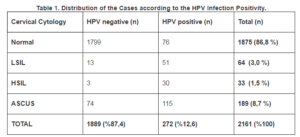
The 79,2 % (n=91) of HPV (+) ASCUS cases had normal cervical cytology, while 15,6% (n=18) had low grade cervical intraepithelial lesions (LSIL) and 5,2 % (n=6) had high grade SIL (HSIL) (Table 2).

Considering all the cases, 94,4 % (n=2040) had normal cytology, 3,8 % (n=82) had LSIL and 1,8 % (n=39) had HSIL (Table 3).
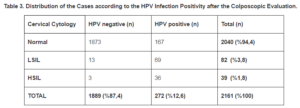
HPV infection has been determined in 8,19% (n=167) of cases with normal cervical cytology, 84,15% (n=69) of cases with LSIL and 92,3% (n=36) of cases with HSIL. HPV presence in LSIL and HSIL are higher than normal cervical cytology (p0,05).
As the result of the evaluation of the HPV positive patients, it has been found that 61% (n=167) of the patients had normal, 25,4% (n=69) had LSIL and 13,2% (n=36) had HSIL cervical cytology. The incidence of HPV positivity was 12,6% (n=272). The most common subtype was HPV type 6 (n=109, 5%) while the incidences of the other subtypes from second most common to least common were as follows; type 18 (n=63, 2,9%), type 16 (n=53, 2,4%), type 11 (n=20, 0,9%), type 45 (n=10, 0,4%), type 52 (n=10, 0,4%), type 59 (n=4, 0,18%) and type 51 (n=3, 0,14%). Among the HPV positive patients, the most common HPV subtype was type 6 (n=108, 40%), and the other subtypes were type 18 (n=63, 23,2%), type 16 (n=53, 19,5%), type 11 (n=20, 7,3%), type 45, 51, 52 and 59 (Figure 1).
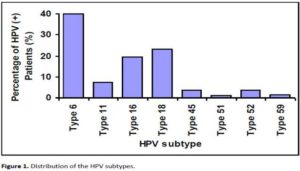
Distribution of the HPV subtypes according to the age groups has been shown (Figure 2).
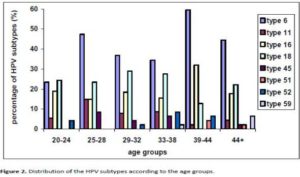
The HPV subtypes determined in cases with normal cytology from the most common to the least common were type 6 (n=72, 43, %), type 18,16, 11, 52, 45, 51 and 59. In the cases with LSIL cytology, HPV subtype 6 (n=6, 52,2%) was the most common, on the other hand, HPV type 18 (n=21, 58,3%) and type 16 (n=11, 30,5%) were most common in the cases with HSIL cytology (Figure 3).
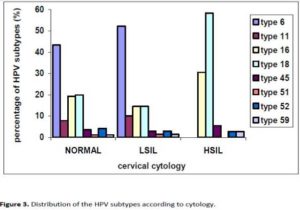
The patients were also questioned about their delivery frequencies. The 30,5% (n=83) of the HPV positive patients were nulliparous, while 19,8% (n=34) were primipar, and the rest were multipar; 38,2% (n=104) with two delivery and 11,5% (n=31) with more than two delivery. There was no significant correlation between HPV positivity and parity (p>0,05).
Discussion
Genital HPV infection is the most common sexually transmitted disease. Taking into consideration of all the cervical cancer cases, 99,8% of the patients were infected by HPV. HPV infection may cause either genital wart, precancerous cervical lesions or cervical cancer. While more than 100 HPV subtypes exist, 30 subtypes may lead to infection in human. According to the oncogenicity potential, HPV types are classified as high risk (HR; type 16, 18, 31, 45, 51, 52, 59, 68) and low risk (LR; type 6 and 11) (1-4).
HPV infection prevalence exhibits regional variations. The incidence of HPV among 14-59 years of age Americans is 26,8% and the most common HPV subtype is type 6 (1,3%) (14), while this incidence is 17% in Spaniens and the most common HPV subtype is type 16 and 18 (15). On the other hand, among Indian women, type 16 is the most common HPV subtype and the incidence is 7,6% (16), in Denmark the percentage of the HPV infected women is 26,4 % type 16 is the most common one (6,0%) (17). In our study, screening 2161 patients, the incidence of HPV infection was found to be 12,6 % (n=272) and the most common HPV type was type 6 (n=109, 5%).
The incidence of the other subtypes were as follows; type 18 (n=63, 2,9%), type 16 (n=53, 2,4%), type 11 (n=20, 0,9%), type 45 (n=10, 0,4 %), type 52 (n=10, 0,4%), type 59 (n=4, 0,18%) and type 51 (n=3, 0,14%).
In our population group, although the HPV infection was most common in ages between 33 and 38 (n=58, 21,3%), no correlation has been found between the HPV infection incidence and the age (p>0,05). Among all the age groups, HPV type 6 was the most common. The highest frequency of HPV was in the age group 24-29 in USA (27,5%)14 and 20-25 in Denmark (50,2 %)17. In our study, the HPV infection was more common in the primipar and multipar (the women who had two delivery) women groups compared to the others.
HPV infection is one of the main causes of precancerous cervical lesions. Among the patients with normal cervical cytology (n=2040, 94,4%), the HPV infection frequency was 8,19% (n=167), while it was 84,15% (n=69) in the LSIL group (n=82, 3,8%) and 92,3% (n=36) in the HSIL (n=39, 1,8%). Kjaer et. al. cytologically examined 11,617 women and detected that 94% of the women had normal cytology, 4,3% had LSIL and 1,6% had HSIL. HPV type 16 (6%) is the most common subtype which infected the 53,2 % of the HSIL cases17. On the other hand, Bhatla et.al. found that the prevalence of the HPV infection was 7,6% in normal cervical cytology, 42,3% in LSIL and 87,5% in HSIL group patients16 . In the study of Bernal et.al., it was found that 17% of the patients with normal cytology was infected with HPV. 66% of CIN 1, 71% of CIN 2 and 90% of CIN 3 cases were HPV positive and it was mentioned that the most frequent subtypes were type 16 and type 1815.
In our study, the most common subtypes of HPV in cases with normal cytology and LSIL were 6 (43,3% and 52,2%, respectively), while the most prevalent HPV subtypes in the cases with HSIL were type 18 (58,3%) and type 16 (30,5%). The frequencies of type 6, 11, 16 and 18 were 40%, 7,3%, 19,5% and 23,2% respectively, and these subtypes constituted the 90% of all HPV infectioned women population.
At present, bivalant (Cervarix-type 16, 18) and quadrivalant (Gardasil-type 6, 11, 16, 18) vaccines are ready to use in the clinical practice and they were shown to be 100% effective in the profilaxis of the HPV subtypes in their spectrum. 88,8% of the HSIL are caused by type 16 and 18. Thus, by the use of the appropriate vaccination programs, the significant amount of the precancerous cervical lesions and cervical cancer that might be prevented.
References
Bernal, M., Burillo, I., Mayordomo, J. I., Moros, M., Benito, R., Gil, J. (2008). “Human Papillomavirus (HPV) İnfection and İntraepithelial Neoplasia and İnvasive Cancer of the Uterine Cervix: A Case-Control Study in Zaragoza, Spain,” Infect Agent Cancer. 29;3:8.
Publisher – Google Scholar
Bhatla, N., Dar, L., Rajkumar Patro, A., Kumar, P., Pati, S. K., Kriplani, A., Gulati, A., Broor, S., Iyer, V. K., Mathur, S., Shah, K. V., Gravitt, P. E. (2008). “Human Papillomavirus-Type Distribution in Women with and without Cervical Neoplasia in North India,” Int J Gynecol Pathol. 27(3):426-30.
Publisher – Google Scholar – British Library Direct
Carter, J. J., Koutsky, L. A., Hughes. J. P., Lee, S. K., Kuypers, J., Kiviat, N. & Galloway, D. A. (2000). “Comparison of Human Papillomavirus Types 16, 18, and 6 Capsid Antibody Responses Following İncident İnfection,” J Infect Dis181:1911-9.
Publisher – Google Scholar – British Library Direct
Chew, G. K., Cruickshank, M. E., Rooney, P. H., Miller, I. D., Parkin, D. E. & Murray, G. I. (2005). “Human Papillomavirus 16 İnfection in Adenocarcinoma of the Cervix,” Br J Cancer 93:1301-4.
Publisher – Google Scholar – British Library Direct
Clifford, G., Franceschi, S., Diaz, M., Munoz, N., Villa, L. L. (2006). Chapter 3: “HPV Type-Distribution in Women with and Without Cervical Neoplastic Diseases,” Vaccine 24:S26-34.
Publisher – Google Scholar
Clifford, G. M., Smith, J. S., Aguado, T., Franceschi, S. (2003). “Comparison of HPV Type Distribution in High-Grade Cervical Lesions and Cervical Cancer: A Meta-Analysis,” Br J Cancer 89:101-5.
Publisher – Google Scholar – British Library Direct
Clifford, G. M., Smith, J. S., Plummer, M., Munoz, N., Franceschi, S. (2003). “Human Papillomavirus Types in İnvasive Cervical Cancer Worldwide: A Meta-Analysis,” Br J Cancer 88:63-73.
Publisher – Google Scholar – British Library Direct
Food and Drug Administration. (2006). Gardasil (Quadrivalent Human Papillomavirus [Types 6, 11, 16, 18] Recombinant Vaccine) [Package İnsert]. Whitehouse Station, NJ: Merck & Co; http://www.fda.gov/cber/label/HPV.
IARC (2006). ‘Monographs on the Evaluation of Carcinogenic Risks to Humans,’ Volume 90, Human Papillomaviruses. Lyon: International Agency for Research on Cancer.
Kjaer, S. K., Breugelmans, G., Munk, C., Junge, J., Watson, M., Iftner, T. (2008). “Population-Based Prevalence, Type- and Age-Specific Distribution of HPV in Women before İntroduction of an HPV-Vaccination Program in Denmark,”Int J Cancer. 15;123(8):1864-70.
Publisher – Google Scholar
Koutsky, L. A., Ault, K. A., Wheeler, C. M. et al; (2002). Proof of Principle Study Investigators. “A Controlled Trial of a Human Papillomavirus Type 16 Vaccine,” N Engl J Med 347:1645—1651.
Publisher – Google Scholar – British Library Direct
Moscicki, A. B., Schiffman, M., Kjaer, S. & Villa, L. L. (2006). Chapter 5: “Updating the Natural History of HPV and Anogenital Cancer,”Vaccine 24:S42-51.
Publisher – Google Scholar
Munoz, N., Bosch, F. X., Castellsague, X., Diaz, M., De Sanjose, S., Hammouda, D., Shah, K. V. & Meijer, C. J. L. M. (2004). “Against Which Human Papillomavirus Types Shall We Vaccinate and Screen? The İnternational Perspective,” Int J Cancer 111:278-85.
Publisher – Google Scholar – British Library Direct
Smith, J. S., Lindsay, L., Hoots, B., Keys, J., Franceschi, S., Winer, R. & Clifford, G. M. (2007). “Human Papillomavirus Type Distribution in İnvasive Cervical Cancer and Highgrade Cervical Lesions: A Meta-Analysis Update,” Int J Cancer1;121(3):621-32.
Publisher – Google Scholar
US Centers for Disease Control and Prevention. ACIP Provisional Recommendations for the Use of Quadrivalent HPV Vaccine. http://www.cdc.gov/nip/recs/provisional_recs/hpv.
Villa, L. L., Costa, R. L., Petta, C. A. et al. (2005). “Prophylactic Quadrivalent Human Papillomavirus (Types 6, 11, 16, And 18) L1 Virus-Like Particle Vaccine in Young Women: A Randomised Double-Blind Placebo-Controlled Multicentre Phase II Efficacy Trial,” Lancet Oncol 6:271—278.
Publisher – Google Scholar








